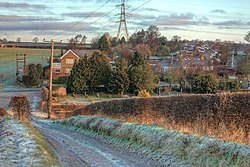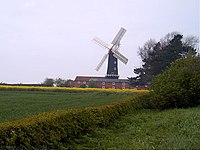Skidby
| Skidby | |
| Yorkshire East Riding | |
|---|---|

| |
| Location | |
| Grid reference: | TA014336 |
| Location: | 53°47’22"N, 0°27’41"W |
| Data | |
| Population: | 1,284 (2011) |
| Post town: | Cottingham |
| Postcode: | HU16 |
| Dialling code: | 01482 |
| Local Government | |
| Council: | East Riding of Yorkshire |
| Parliamentary constituency: |
Haltemprice and Howden |
Skidby is a small village in Yorkshire Wolds of the East Riding of Yorkshire. It is situated about six miles north-west of Kingston upon Hull city centre, two miles west of Cottingham and five miles south of Beverley.
The village has a single main street, Main Street, running roughly east–west: the eastern end leads to Cottingham, making a crossroads with the former Hessle to Beverley turnpike.
The parish church, St Michael dates to 1777, with a tower built in 1827. It is a Grade II* listed building.[1]
The wider civil parish also includes two hamlets: Eppleworth and Raywell. The 2011 census recorded a parish population of 1,284.
In the village stands Skidby Windmill, a Grade II* listed building.[2]
Contents
Name
The village name 'Skidby' is first recorded by Oswald, Archbishop of York in the 10th century, as Scyteby. In the Domesday Book of 1086, it appears as Schitebi.
The village's name is thought mean 'Skítr's Farm', of Scandinavian origin.[3] An alternative origin meaning 'firewood place' (from skið and by), an origin from the person's name skiði has also been suggested. Other alternatives are 'dirty place', from the old English scite.
History
The village is first recorded by Oswald, Archbishop of York in the 10th century: Bishop Oscytel was recorded as having acquired it for £20.[4]
The Doomsday Book records Schitebi together with 'Burtone' (near Bishop Burton): the land belonged to the manor of Beverley (in the hands of the church), with over 20 villains and 3 knights.[5]
The church of St Michael dates to 1777. Weslyan and Baptist chapels were built in the early 1800s, and a school and teacher's house built in 1849. A corn mill, Skidby Mill was constructed in 1821, and raised in the 1870s.
By the 1850s the village population had reached 306; in 1857 the ecclesiastical parish of Skidby became fully separated from Cottingham and received a resident clergyman.
Around 1885 the Hull and Barnsley Railway was constructed (section closed 1960s), running north-east through the parish: no stations were constructed on the section near Skidby; at the point the railway crossed the Eppleworth valley a five arched brick viaduct was constructed, known locally as 'five arches', or as 'Eppleworth viaduct'.[6]
North-west of the viaduct the line required an 83-foot cutting, known as the Little Weighton Cutting.
In 1972, 120 acres of land north of the Eppleworth to Raywell road was acquired for the Hessle Golf Club, which was relocating due to the construction of the Humber Bridge; the eighteen-hole course was opened in 1975.[7]
Outside links
| ("Wikimedia Commons" has material about Skidby) |
References
- ↑ National Heritage List 1103341: Church of Saint Michael
- ↑ National Heritage List 1103339: Skidby Mill and Attached Mill Buildings (Grade II* listing)
- ↑ Mills, Anthony David: 'A Dictionary of British Place-Names' (Oxford University Press, 2003) ISBN 978-0-19-852758-9
- English Place-Name Society. 14. 1937. p. 209. https://books.google.com/books?id=3YRnAAAAMAAJ.
- ↑ "LIV. Statement given by Oswald, Archbishop of York, regarding church lands in Northumbria". anglo-saxon charters. CUP Archive. 1973. pp. 112–3. https://books.google.com/books?id=zdY5AAAAIAAJ&pg=PA112. "æt Scyteby he gebohte mid .XX pundun"
- ↑ Poulson, George (1829). Beverlac; or, The antiquities and history of the town of Beverley in the county of York, and of the provostry and collegiate establishment of St. John's ... 2. p. 515. https://books.google.com/books?id=mgcIAAAAQAAJ.
- ↑ "Collections – Search Results: "Black and white photograph depicting the Eppleworth Viaduct, with trucks passing across the top"". Hull museums collection. Hull City Council. http://www.hullcc.gov.uk/museumcollections/collections/search-results/display.php?irn=64810.
- ↑ "Hessle Golf Club : Superb Golf Course in East Yorkshire". Hessle Golf Club. History. http://hesslegolfclub.co.uk.
- Gazetteer — A–Z of Towns Villages and Hamlets. East Riding of Yorkshire Council. 2006. p. 10.

